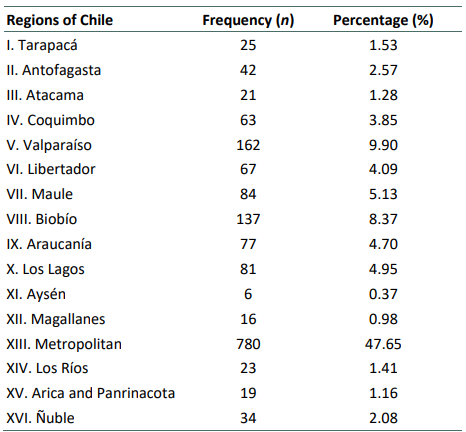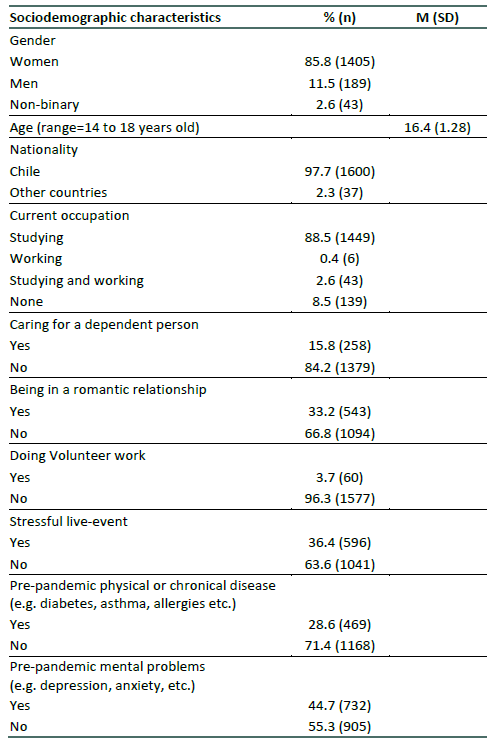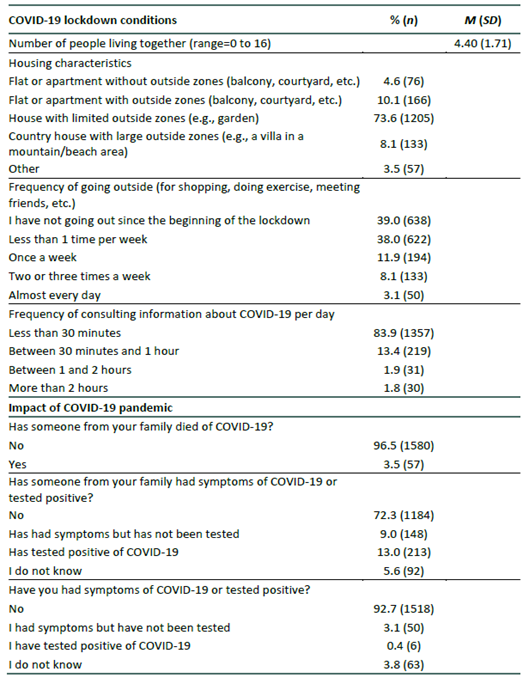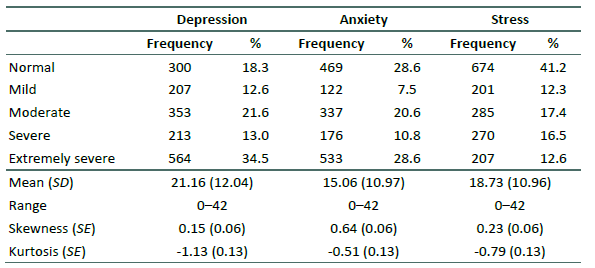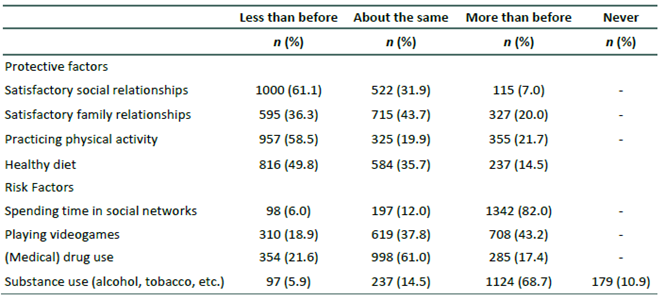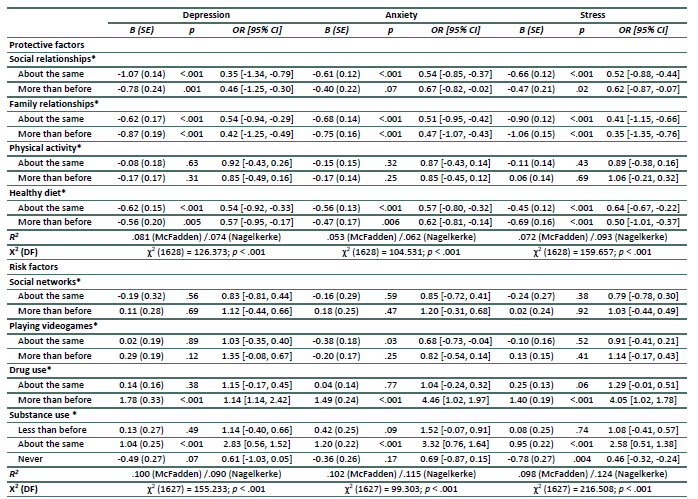Introduction
The pandemic generated by the coronavirus disease has caused a health, economic, social and humanitarian crisis around the world (WHO, 2020). It is a situation that has led different countries to make various changes and adopt different measures in order to prevent a collapse in health systems (Chilean Ministry of Health, 2020b). Among the changes and measures that have been carried out worldwide, there are those that entail a change in the way of relating socially, specifically, the measures of social distancing or isolation, which have been linked to an increase in psychological problems (Huremović, 2019; Mucci et al., 2020). Studies conducted prior to the pandemic have observed that isolation causes an increase in depressive symptoms and suicidal thoughts in the adolescent population, as well as has been generally related to the development of serious mental problems (Huremović, 2019). However, when social isolation is derived as a result of being in a situation of global pandemic, the psychological consequences that this situation can cause are more serious and substantially affect mental health, especially in the case of adolescents (Mucci et al., 2020).
Adolescence is a very important stage of development, which marks the transition from childhood to adult life (Güemes-Hidalgo et al., 2017). It is stage of great psychological vulnerability to coincide with the experimentation of biopsychosocial changes, which have been associated with the increase in the experimentation of problems at the emotional, social and behavioral level (Alarcón & Bárrig, 2015). Generally, various investigations have indicated that during this stage different emotional and somatic symptoms are experienced, the most frequent in this population being the experimentation of anxiety and depression (Martínez Monteagudo et al., 2013), two emotional problems very comorbid with each other (Salavera & Usán, 2019). There are also differences depending on sex, with girls most frequently experiencing symptoms of depression and anxiety (Alarcón & Bárrig, 2015); and age, with older adolescents experiencing the most emotional symptoms (Salavera & Usán, 2019).
The number of studies carried out on mental health problems in both Chilean and Latin American adolescents in general is very small. However, they highlight the mental health problems presented by Chilean adolescents. Studies on the prevalence of psychiatric disorders in the Chilean child and adolescent population have shown over the years that there is a higher prevalence of symptoms of depression and anxiety compared to that of other countries (Vicente et al., 2016). These results are in line with a report by the WHO, in which Chile stood out for being one of the countries with the highest prevalence of depression, as well as for having a high percentage of the general population that suffers from anxiety (WHO, 2017).
Mental health problems, along with going through a difficult developmental period such as adolescence, are also associated with an increase in risk behaviors (Alarcón & Bárrig, 2015). When people are experiencing stressful life events they can experience a series of changes at the physiological, emotional and behavioral level, and among the behavioral changes we find the consumption of substances such as alcohol or tobacco (Wang et al., 2020). The consumption of psychoactive substances or drugs is one of the risk behaviors associated with the presence of mood problems (Vilugrón Aravena et al., 2017). Adolescence and, especially, the so-called late adolescence (between 15-17 years) has been considered one of the stages of greatest vulnerability and greatest risk of consumption according to the United Nations Office on Drugs and Crime (Oficina de las Naciones Unidas contra la Droga y el Delito [UNODC], 2018). Likewise, drug use is especially relevant in the Chilean adolescent population, since according to data from the Global Health Observatory data repository of the WHO, more than 70% of the population between 13-15 years of age has consumed alcohol before 14 years of age, and more than 60% of adolescents between 15-19 years had consumed alcohol at that current time (WHO, 2016) . Similarly, it has been observed that not only is there an early onset of alcohol consumption in this population, but that there is a large percentage of adolescents who start early in the use of tobacco and other drugs (Vilugrón Aravena et al., 2017).
In the current context marked by the COVID-19 pandemic, adolescence is associated with mental health problems, as indicated by some studies carried out in different countries on the psychological impact of the pandemic in the adolescent population (Huremović, 2019; Magson et al., 2021; Mucci et al., 2020; Tamarit et al., 2020). During the pandemic situation and the confinement, several studies have indicated that the perception of symptoms of anxiety and depression in adolescents has increased (Mohamed-Azzam Zakout et al., 2020; Tamarit et al., 2020), as well as a greater affectation has been observed in those adolescents who had previous mental health problems (Mensi et al., 2021; Thomas, 2020). Differences in age and sex have also been observed in symptom experimentation, as girls have perceived more emotional symptoms (Chen et al., 2020; Magson et al., 2021) and younger adolescents less (Gómez-Becerra et al., 2020).
Compliance with measures such as isolation and social distancing have had negative psychological consequences in adolescents, as they have reported increased experimentation with symptoms of depression and anxiety (Tamarit et al., 2020). Likewise, this situation has had consequences in the change of personal health and leisure habits, since there are studies that indicate that adolescents during this situation have done less physical activity and have eaten less healthy than before (León & Arguello, 2020; Robinson et al., 2021), as well as have increased the time they spend in front of screens to spend time (Ellis et al., 2020; Orgilés et al., 2020).
Although several investigations have already been carried out in different countries on the psychological impact that the global pandemic caused by COVID-19 has caused on the health of the adolescent population (Huremović, 2019; Magson et al., 2021; Mucci et al., 2020; Tamarit et al., 2020) there is still no scientific evidence regarding the Chilean adolescent population. The psychological impact can include different emotional reactions such as symptoms of depression, anxiety and stress that usually increase in situations of high psychological stress and threats of an unpredictable and uncontrollable nature, with variations depending on the characteristics of the situation and the individual himself. Thus, the aim of this study was to determine the mental health status of the Chilean adolescent population during confinement, the changes that have occurred in psychological functioning because of the pandemic situation, and what vulnerability/risk and protective factors have influenced mental status. Based on this general objective, three specific objectives have been proposed to investigate: (a) the mental health status of the Chilean adolescent population during the COVID-19 confinement; (b) changes in psychological functioning associated with the psychosocial stress situation of the COVID-19 pandemic; (c) risk and protective factors that could influence that mental health status.
Method
Participants
Self-report data were collected form 1637 adolescents (85.83% female, 11.55% male, 2.63% non-binary) aged between 14 and 18 years (M age = 16.40; SD = 1.28) from all regions of Chile (Table 1). Inclusion criteria for participation in the study were: (1) age between 14 and 18 years, and (2) living in Chile during the lockdown established by the government due to the COVID-19 pandemic. The distribution of the sample according to nationality was as follows: Chile (n = 1600), Venezuela (n = 16), Colombia (n = 7), Argentina and Peru (n = 3), Cuba, Bolivia and Spain (n = 2), Ecuador and Haiti (n = 1).
Instruments
Data collection on the socio-demographic characteristics of the participants was carried out through an ad-hoc questionnaire. Data were collected on gender, age, nationality, current occupation, whether they were caring for a dependent person, whether they were in a romantic relationship, whether they did volunteer work, whether they had experienced any stressful events prior to the pandemic, and whether they had any physical or chronic illness or mental health problems prior to the pandemic. Also, about the conditions in which they had lived in confinement (the number of people they lived with, the characteristics of their housing, how often they went outside and how often they consulted information about COVID-19) and about the impact of the pandemic (whether anyone in the family had tested positive or died from COVID-19, as well as whether the participant themselves had had symptoms of COVID-19 or tested positive).
Changes in psychological functioning and general health status was assessed using 21 ad hoc questions. The participants were asked to answer whether certain health indicators occur 1= much less than before the pandemic; 2= less than before, 3= the same as before, 4= more than before, or 5= much more than before. These indicators correspond to various areas of psychological functioning and general health: social and family relationships (e.g., "My social relationships are satisfactory"), performance of physical exercise (e.g., "I do physical exercise"), food-related (e.g., "I am eating healthy"), use of digital technologies (e.g., "I use electronic devices"), and the use of medical drugs and other substances (e.g., "I use drugs/medications").
Emotional symptoms were assessed using the Depression, Anxiety and Stress Scale (DASS) (Lovibond & Lovibond, 1995). Specifically, the scale adapted and validated in Chilean students, DASS-21, was used. (Antúnez & Vinet, 2012). The scale consists of 21 items with 4 response options ranging from 0 (not at all applicable to me) to 3 (very applicable to me, or applicable most of the time). The items are grouped evenly into the three subscales that are assessed: depression (e.g., “I couldn’t seem to experience any positive feeling at all”), anxiety (e.g. “I was aware of dryness of my mouth”) and stress (e.g, “I found it difficult to relax”). This scale showed excellent reliability indexes in the study’s sample: depression (α=.93; ω=.88), anxiety (α=.87; ω=.88), and stress (α=.90; ω=.89). The construct validity of the scale was tested and the 3-factor structure showed an adequate fix (Basha & Kaya, 2016).
Study design and procedure
The study follows a descriptive and cross-sectional study design using a “snowball” sampling method. Data were collected during 10 days between May 22 and June 2, 2020. At that time, Chile was one of the most affected countries by the COVID-19 outbreak in Latin America with an continuous increase in confirmed cases and deaths (from 3964 to 5471 confirmed cases and from 45 to 59 deaths during the data collection) (WHO, 2020). As a result, the Chilean government had adapted several measures in response to the rapid spread of the coronavirus, which included closures of schools, universities and non-essential shops, cancelations of public events, restrictions of mobility and total confinement of the population. According to the Oxford COVID-19 Government Response Tracker, the government response in Chile during data collection corresponded to a lockdown stringency index of 78.24 (index ranges between 1-100), which indicates a strict lockdown (Hale et al., 2021).
Self-report data were collected through an online survey, which was distributed through banners posted on social networks (Facebook, Twitter, Instagram, etc.), using an electronic link with direct input to a secure database (Limesurvey). The publication through these platforms, in addition to the link, contained important information regarding the conditions of the study and the collection of written informed consent. Participants were informed of the confidential treatment of their data and the anonymity of their responses. Participation was entirely voluntary, with no reward offered in exchange for the answers provided. Data collection followed the established standards of the Declaration of Helsinki (World Medical Association, 2013).
Data analysis
Data were analyzed with the statistical package SPSS version 26. descriptive statistics were used to analyze the participants’ socio-demographic characteristics, conditions during COVID-19 pandemic and lockdown, the prevalence of emotional symptoms and changes in personal and social habits. Multiple logistic regression analyses were conducted to identify possible risk and protective factors that predict emotional symptoms among Chilean adolescents.
Results
Participants’ sociodemographic characteristics
Table 2 shows participants’ socio-demographic characteristics, including basic demographic data as well as personal and social information about current occupation, in charge of a depended person, relationship status, volunteer work, recent stressful life-event, pre-pandemic physical, chronical disease and mental problems.
Conditions during COVID-19 pandemic and lockdown
The conditions during the hard lockdown in Chile are displayed in Table 3. On the one hand, they capture the living situation (number of people living together, housing characteristics, frequency of going outside and consulting information about COVID-19), on the other hand, the effect on family and relatives (positive cases, death in the family due to COVID-19).
Prevalence of emotional symptoms during lockdown
Overall, participants showed high levels of depression, anxiety and stress symptoms during the national lockdown due to the COVID-19 outbreak in Chile (Table 4). Depressive symptoms appeared to be the most frequent, anxiety symptoms were also high in frequency, while stress symptoms were the least frequent.
Changes in psychological functioning related to COVID-19 pandemic and lockdown
Adolescents reported a change in behavior or habits and in psychological functioning associated with the COVID-19 pandemic and lockdown in Chile (Table 5).
Although the vast majority of participants in this study reported having less satisfactory social relationships than before the pandemic, many of them maintained satisfactory relationships with their family or even have improved them during the confinement. However, most adolescents practiced less physical activity and started to eat less healthy than before the pandemic.
Adolescents may have struggled with the consequences of COVID-19 pandemic and strict lockdown, using maladaptive coping strategies. Thus, a significant number of participants have reported spending more time in social networks than before the pandemic and playing videogames more often to pass the time. While the frequency of using medical drugs haven’t changed, there has been a significant increase in substance use (alcohol, tobacco) since the beginning of the lockdown.
Prediction of mental health in adolescents
Logistic regression analyses were conducted to identify potential risk and protective factors among sociodemographic characteristics, conditions during COVID-19 pandemic and changes in psychological functioning, and to which extent they might predict depression, anxiety and stress symptoms in Chilean adolescents. Participants were classified according to their score on the DASS-21 questionnaire into two groups, depending on whether or not they had experienced emotional symptoms (No = 1, Yes = 2). Three logistic regression models were performed for each of the DASS-21 scales by three blocks of variables, a total of nine models.
Regarding sociodemographic effects (Table 6), girls were more likely to experience depression, anxiety and stress symptoms than boys during the COVID-19 pandemic and lockdown. Younger adolescents were less likely to perceive stress. Participants who were in a romantic relationship, were feeling less anxious and stressed compared to those who did not. Having experienced a stressful life-event recently also contributed to depression, anxiety and stress symptoms. Adolescents, who have reported pre-pandemic mental problems, were more likely to present emotional symptoms during the strict lockdown.
With regard to conditions during COVID-19 pandemic and lockdown (Table 7), all three logistic regression models were non-significant (p >. 05). These results indicate that the household size, housing characteristics, the frequency of going outside and consulting information about the pandemic, the fact that a family member or oneself has been infected with the virus or even died from its consequences appear to be unrelated to adolescents’ emotional symptoms. Although the total prediction model was not significant, a statistically significant effect was observed of consulting information about COVID-19 on depression. Thus, the more time adolescents spent watching/searching the news about COVID-19 pandemic, the more depressed they felt.
Analyzing the impact of changes in psychological functioning (Table 8), a negative effect was observed of satisfactory social and family relationships. These results indicate that adolescents, who were able to strengthen their relationships with friends and family during the COVID-19 pandemic, experienced lower levels of depression, anxiety and stress symptoms. A healthy diet also contributed to less emotional symptoms. Adolescents who were spending more time playing video games, were more likely to present symptoms of anxiety. An increased use of (medical) drugs and other substance such as alcohol and tobacco, was a significant predictor of feeling more depressive, anxious or stressed during the strict lockdown.
Table 6 Logistic regression models of sociodemographic characteristics predicting depression, anxiety and stress symptoms.
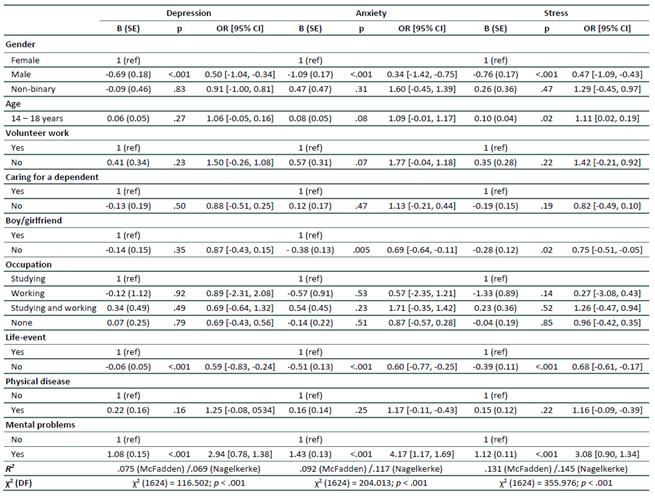
Table 7 Logistic regression models of conditions during COVID-19 pandemic and lockdown predicting depression, anxiety and stress symptoms.
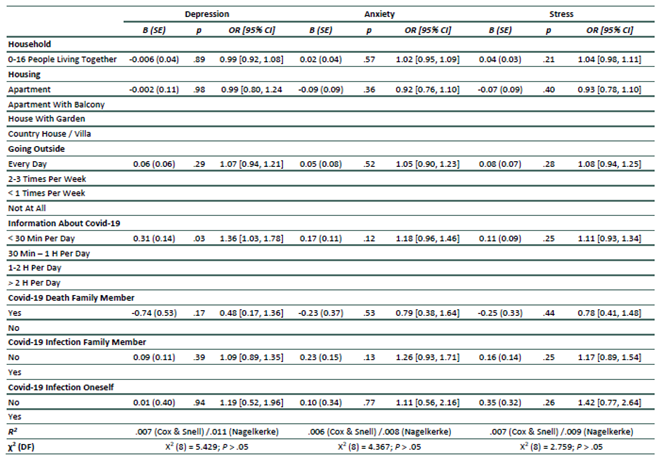
Discussion
The aim of this study was to determine the mental health status of Chilean adolescents during confinement, the changes that have occurred in psychological functioning because of the pandemic situation, and what risk and protective factors have influenced their mental health.
Our first aim was to determine the mental health status of the Chilean adolescent population during the COVID-19 confinement. Our results show that most adolescents reported extremely severe levels of depression and anxiety. This finding is in line with previous studies that have observed an increase in depression and anxiety problems in adolescents during the pandemic and the confinement situation. Furthermore, our results have indicated gender differences, showing that girls are more likely to experience symptoms of depression, anxiety and stress compared to boys during confinement. This result is in line with the literature (Chen et al., 2020; Magson et al., 2021; Mohamed-Azzam Zakout et al., 2020; Tamarit et al., 2020), as well as being related to the results of various research studies conducted prior to the pandemic situation which show that girls perceive more emotional symptoms than boys in general (Alarcón & Bárrig, 2015; Salavera & Usán, 2019). However, it should be taken into account that our results may be influenced by the fact that the sample studied has a higher percentage of girls. Differences by age have also been observed. Our results show that younger adolescents have a lower propensity to perceive stress, a result that is partially related to previous studies that have indicated that they tend to perceive fewer emotional symptoms in general, both in the context of pandemics and in the context of a pandemic as in a normal context (Chen et al., 2020; Gómez-Becerra et al., 2020).
Our next aim was to analyze changes in psychological functioning. Our results indicate changes in social and personal habits. Most of the adolescent’s report that their social relationships before the pandemic were more satisfying, with a very small percentage reporting that their relationships improved during confinement. Similarly, slightly less than half of adolescents report more satisfying family relationships (Lacomba-Trejo et al., 2020). Encouraging positive family relationships is very important, as it is considered a protective variable in the face of difficulties and as it has been observed that families with a positive relationship adapt better to difficult situations when experiencing stressful events (Prime et al., 2020). In terms of personal health habits, our results indicate that more than half of adolescents are less physically active and eat less healthily than before the pandemic, a result that is consistent with previous studies (Ellis et al., 2020; León & Arguello, 2020; Robinson et al., 2021). Also, results indicated that the frequency of medication use is the same in more than half of the adolescents, however, the use of alcohol and/or tobacco has increased significantly. In terms of personal leisure habits, our results showed that a high number of adolescents spend more time on social networks than before and less than half reported playing video games more frequently. This result is related to those obtained in previous studies, as adolescents have reported an increase in screen time during lockdown (Ellis et al., 2020; Orgilés et al., 2020).
Our final aim was to determine the risk and protective factors that may influence mental health status. Regarding risk factors, it was observed that variables such as the size of the household, the housing characteristics, the frequency of going outside, consulting information about the pandemic, the infection of a family member or oneself with the virus, or even a death because of the disease, were not related to the perception of emotional symptoms in adolescents. This result is contrary to those obtained in previous studies where variables such as the size of the household or the frequency of going outside have been found to be related to the development of emotional symptoms (Tamarit et al., 2020). However, it has been found that looking for information about COVID-19 has a significant association with depression, indicating that the more time adolescents spend viewing or searching for news about the pandemic, the more depressed they feel. Previous studies have indicated that seeking information about COVID-19 has been linked to experiencing stress (Mohamed-Azzam Zakout et al., 2020), anxiety (Magson et al., 2021; Tamarit et al., 2020) and depression (Mohamed-Azzam Zakout et al., 2020). Furthermore, our results indicated that experiencing a recent stressful life event contributed to the experience of depression, anxiety and stress symptoms, a finding that is consistent with previous findings in the literature (Jones et al., 2021; Tamarit et al., 2020). Also, in our study, when adolescents reported more pre-pandemic mental health problems, they were more likely to experience emotional symptoms during lockdown. This finding has been observed in other research that has indicated poor mental health in the majority of adolescents with pre-pandemic mental health problems (Mensi et al., 2021; Thomas, 2020).
Another relevant finding is the importance of personal health habits, thus, adolescents who reported eating a healthy diet reported fewer emotional symptoms. During the pandemic and the lockdown situation, several studies have reported negative changes in food-related habits, with higher Body Mass Index (BMI) being associated with lower diet quality and more frequent overeating (Robinson et al., 2021). In addition, consuming both medication and alcohol or tobacco has been found to be a significant predictor of increased depression, anxiety, and stress during confinement. In terms of personal leisure habits, those adolescents who reported spending more time playing video games were more likely to perceive more anxiety symptoms (Király et al., 2020). On the one hand, substance use and spending time playing video games are behaviors that are often used to reduce emotional symptoms such as depression, stress or anxiety (Király et al., 2020; Sandín et al., 2020).
With respect to protective factors, our results indicate that adolescents who were in a romantic relationship perceived themselves to be less anxious and less stressed than those who were not, a result that with respect to stress has been observed previously (Tamarit et al., 2020). Similarly, satisfying social and family relationships have been found to have a negative effect on the experience of emotional symptoms, showing that those adolescents who strengthened their relationships during the pandemic experienced fewer symptoms of depression, anxiety and stress. During the pandemic, adolescents who were alone were found to experience greater emotional symptoms, such as depression or anxiety, compared to those who were accompanied by family members (Chen et al., 2020; Magson et al., 2021). Our results therefore indicate that social support may have a protective effect on mental health in critical periods such as pandemics (Jones et al., 2021).
One of the main strengths of this study was the large sample of adolescents from all regions of Chile. Similarly, the time at which the data collection took place was at the beginning of the pandemic, a key moment for collecting data and analyzing the impact of this COVID-19 pandemic and lockdown on Chilean adolescents’ psychological functioning and emotional symptoms. Finally, this study has identified possible risk and protective factors for the adolescents' mental health, which we consider to be one of the most important contributions of this research.
Nevertheless, this study has some limitations that need to be considered. The data were collected through a self-report questionnaire where participants answered subjectively based on their self-observation of their behavior, thoughts, emotions, and perceptions. Therefore, in future research should use complementary techniques that collect data in a more objective way. Furthermore, the snowball sampling method used in this study does not guarantee that the sample is representative of the adolescent population in general and, therefore, the results obtained should not be generalized to the whole populations of Chilean adolescents. Similarly, our sample is composed of more adolescent girls than boys, so it would be necessary to obtain a more equitable sample in terms of gender and age of the participants in order to obtain more reliable and valid results of the existing differences. In future research it would be advisable to use a more probabilistic sampling method. Finally, the study only provides information about the perception of the experience of emotional symptoms during the pandemic and lockdown and not about the emotional state prior to this situation, and this should be considered when interpreting the results.














